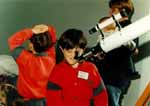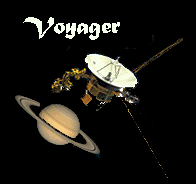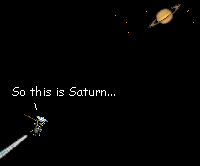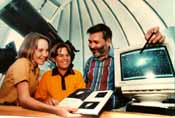

The Cassini Project

Once upon a time, in our Solar System far, far away, the giant planet Saturn traveled around the Sun. When seen through a telescope from Earth, the planet Saturn has beautiful rings around it.
Our Solar System is the "family" of planets, moons, asteroids, and comets that circle (or orbit) around our own star, the Sun. A telescope is a long tube with a system of lenses (similar to those in eyeglasses) inside of it. Some types of telescopes also have mirrors inside. When you look through one end of a telescope, through the eyepiece, it magnifies far away objects and makes them appear much closer. Without the help of a telescope, Saturn appears to be just a very bright star in the night sky.
Even through the biggest telescopes, like the famous one on Mount Palomar in California or the Hubble Space Telescope that is in orbit around the Earth, Saturn is a mystery. It is so far away that we cannot learn very much about it from the Earth. To discover more about this beautiful planet with rings, and to learn more about the other planets in the Solar System, we have built robot spacecraft and sent them out into space to take pictures and perform scientific experiments for us.
What Is It Like On Saturn and What Are the Rings Made Of?

Back in 1977 two twin spacecraft, named Voyager 1 and Voyager 2, were launched from Earth and sent out to explore the Solar System. The Voyagers studied the giant planet Jupiter and its many moons for us, then they flew past the planet Saturn and its moons. Voyager 2 even flew on to the planets Uranus and Neptune far beyond the planet Saturn. Both Voyagers safely passed Saturn just beyond its main rings. Their instruments discovered that the rings are mostly made of water ice in pieces of many sizes, from bits as tiny as grains of sand to chunks as large as houses! All the ice circles Saturn around its middle (or equator). Though the rings look solid in the pictures that the Voyagers took, there are lots of gaps between the pieces of ice.
We also learned that three other planets in the Solar System have rings around them: Jupiter, Uranus, and Neptune. Compared to Saturn, though, their rings are very narrow and contain much smaller amounts of orbiting ice.
The Voyagers also sent back information that told us the planet Saturn is mostly made of gases like hydrogen and helium. (The helium on Saturn is the same as the helium gas we put inside balloons on Earth to make them float!) Under all its clouds and windy storms, Saturn does not have a solid surface! It may only have a tiny, molten, liquid core at its center. Saturn is extremely cold, too. There is no way astronauts will ever be able to walk on the planet Saturn.
Saturn not only has pretty rings, but also many moons that orbit around it. When the Voyagers flew by Saturn they took pictures of the planet's strange and lovely moons. So far, we have found and named 18 moons that circle Saturn! There may be even more that we have not discovered yet.

The Giant Moon Titan
One of Saturn's moons, named Titan, is so large that it is slightly bigger than the planet Mercury! How can a moon be bigger than a planet? A planet circles (or orbits) around the Sun. A moon circles or orbits around a planet. Since Titan does not orbit the Sun by itself, but goes around the planet Saturn, it is a moon and not a planet. Though it is small, Mercury orbits the Sun, so it is a planet. Though it is true that most planets are bigger than most moons.
The moon Titan is so large that it has clouds and an atmosphere. It is the only moon in our Solar System with a significant atmosphere. Though it has "air" surrounding it, humans could not breathe it because some of the gases are poisonous to us and there is no oxygen, which we need. The clouds surrounding Titan are so thick that even the Voyager spacecraft that flew close to the moon could not see its surface. We do not know what the surface of Titan looks like, though we know it must be very cold there. It is possible that Titan has mountains and oceans, but we will not know for sure until we visit Titan again.
The Cassini Spacecraft
To learn more about Saturn, its rings and moons, we need to send another spacecraft there. For that reason, the Cassini (kah-See-nee) spacecraft is being built by NASA and the European Space Agency. The spacecraft has been named "Cassini" to honor the astronomer Jean-Dominique Cassini who studied Saturn's rings long ago.
The Cassini spacecraft will launch sometime in late 1997 and take seven years to reach Saturn. Unlike the Voyagers that flew past Saturn on their way out of the Solar System, Cassini will orbit around Saturn and circle the planet for 4 years. The spacecraft will be about the size of a 30 passenger school bus and weigh 6 tons!
Cassini will be full of scientific instruments and cameras. Over 30,000 color photos will be taken during the mission! The scientific instruments onboard Cassini will help us learn more about Saturn, its rings, and its many moons.

The Huygens Probe
Cassini will also carry a probe to Saturn. The robot probe is named Huygens (Hoy-genz) after another famous astronomer who studied Saturn long ago and who also invented the pendulum clock, the world's first accurate time piece. The probe will be launched by Cassini and attempt to land on the moon Titan. The Huygens will take 2 1/2 hours to reach the surface of Titan. It will fall through Titan's atmosphere slowly under a parachute.
During descent, the probe will send information it gathers back to the Cassini "mothership." The Cassini spacecraft will then relay the valuable measurements to the waiting people back on Earth. If the Huygens probe survives the landing and doesn't tip over so far it cannot send a signal to the Cassini mothership, it may continue to send back information for up to 30 minutes on the surface of Titan! The probe will send us many pictures of Titan and information about the atmosphere and the surface of the moon.

Why Go to Saturn?
Why is it important that we send a robot spacecraft to the planet Saturn and its moons? There are many reasons. Humans are curious and find the adventure of going where few have gone before to be exciting. Just as the Pioneer-11 and Voyager spacecraft were the first robots to fly by Saturn, the Cassini spacecraft will be the first robot to explore the Saturn system by orbiting the planet, while the Huygens probe will be the first robot to touch the mysterious surface of Titan.
Studying other worlds can tell us a lot about our own planet. For example: Comparing the weather on Saturn, including the clouds and violent winds, to the weather on Earth may teach us more about how clouds and hurricanes form here. By studying the chemicals and conditions on the moon Titan, we may learn more about what the Earth was like long ago before life began. Looking out into the Solar System helps us look back and understand ourselves and teaches us to appreciate and protect our own home planet, the Earth.
